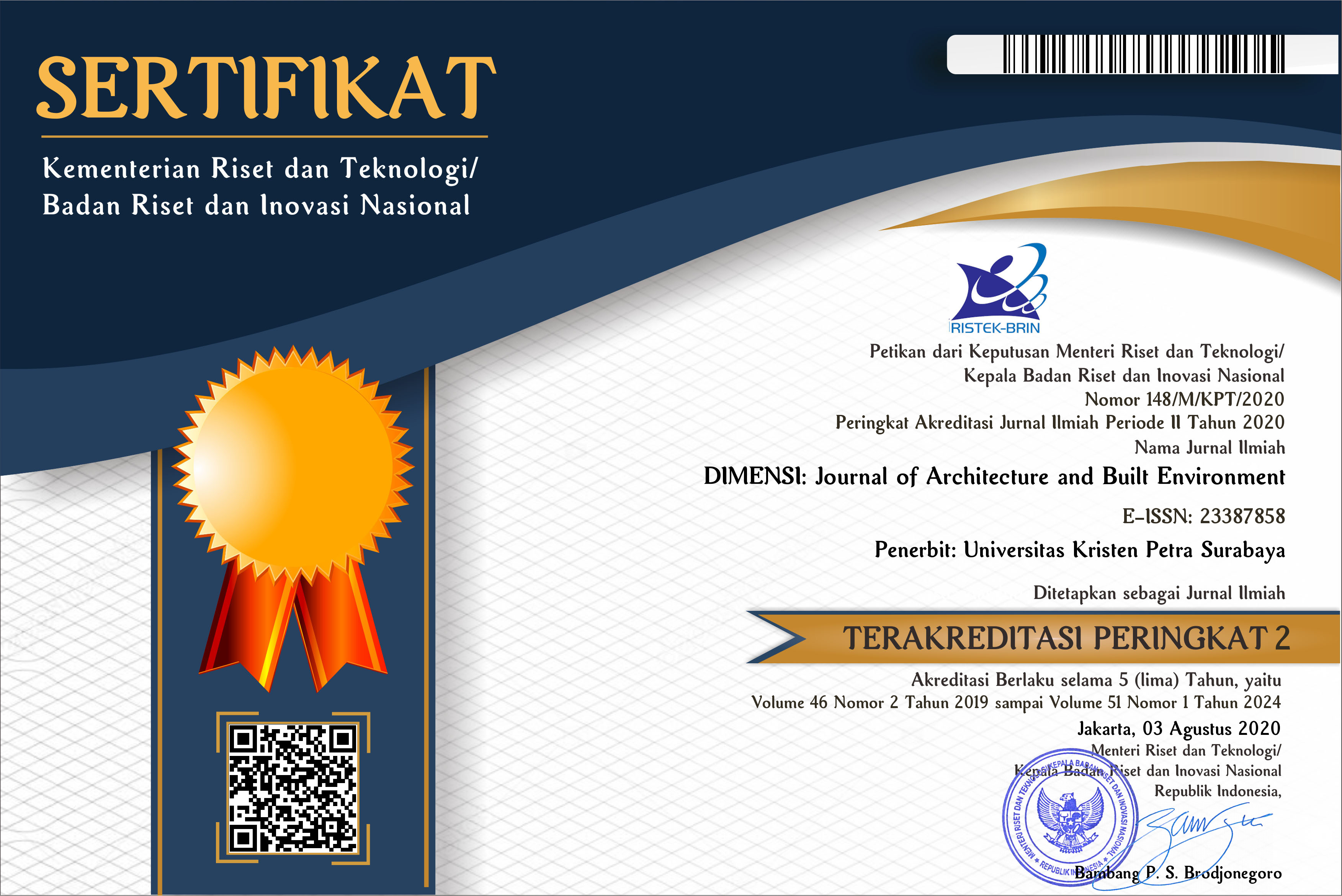OPTIMIZATION STUDY OF VISUAL COMFORT AND DAYLIGHT AVAILABILITY AT CADL ITB
 :
:
https://doi.org/10.9744/dimensi.43.2.107-114
Keywords:
Daylight, glare, spatial daylight autonomy.Abstract
One way to reduce energy consumption in buildings is to use daylighting. However, daylight can cause visual discomfort in the form of glare. Center of Art, Design, and Language (CADL) Institut Teknologi Bandung is a building that has windows on west and east facades, so the probability of glare occurrence is high. In this research, CADL was optimized so that the percentage of time that Daylight Glare Probability below 0.21 (%DGP<0.21) is more than 50% and spatial daylight autonomy with illuminance 150 lux and 50% (sDA150lux,50%) is more than 30%. In the optimization, vertical blinds, horizontal blinds, and curtains were added. Vertical blinds and horizontal blinds were varied by changing the blade’s opening angle and area covering the windows, while curtains were varied only by changing the area covering the windows. The results show that %DGP<0.21 can be increased beyond 50%, but in some rooms, sDA150,50% also decrease below 30%. The most frequent optimum solutions are vertical blinds 75%-60o.
Downloads
References
Aries, M. B. C., Veitch, J. A. & Newsham, G. R. (2010). Windows, View, and Office Characteristics Predict Physical and Psychological Discomfort. J. Environ. Psychol., 30(4), p.533 – 541. [CrossRef]
Greenship Building Council Indonesia (2014). Greenship untuk Bangunan Baru Versi 1.2. Jakarta. [CrossRef]
Ghiaus, C. & Inard, C. (2004). Energy and Environmental Issues of Smart Buildings. A Handbook for Intelligent Building, p.26–51. [CrossRef]
Hirning, M. B., Isoardi, G. L. & Cowling, I. (2014). Discomfort Glare in Open Plan Green Buildings. Energy Build., 70, p.427– 440. [CrossRef]
IESNA. (2012). LM-83-12 IES Spatial Daylight Autonomy (sDA) and Annual Sunlight Exposure (ASE). New York: Illuminating Engineering Society of North America. [CrossRef]
Inanici, M. N. (2006). Evaluation of High Dynamic Range Photography as A Luminance Data Acquisition System. Light. Res. Technol., 38(2), p.123–134. [CrossRef]
Jakubiec, J. A. & Reinhart, C. F. (2012). The ‘Adaptive Zone’ – A Concept for Assessing Discomfort Glare throughout Daylit Spaces. Light. Res. Technol., 44(2), p.149–70. [CrossRef]
Mangkuto, R. A., Asri, A. D., Rohmah, M., Soelami, F. X. N. & Soegijanto, R. M. (2016). Revisiting the National Standard of Daylighting in Indonesia: A Study of Five Daylit Spaces in Bandung. [CrossRef]Sol. Energy, 126, p.276 – 290.
Reinhart, C. F., Mardaljevic, J. & Rogers, Z. (2006). Dynamic Daylight Performance Metrics for Sustainable Building Design. Leukos, 3(1), p. 7–31. [CrossRef]
Wienold, J. & Christoffersen, J. (2006). Evaluation Methods and Development of a New Glare Prediction Model for Daylight Environments with the Use of CCD Cameras. Energy Build, 38, p. 743–757. [CrossRef]
Wymelenberg, K. V. D. & Inanici, M. (2014). A Critical Investigation of Common Lighting Design Metrics for Predicting Human Visual Comfort in Offices with Daylight. LEUKOS, 10(3), p. 145–164. [CrossRef]
Yun, G., Yoon, K. C. & Kim, K. S. (2014). The Influence of Shading Control Strategies on the Visual Comfort and Energy Demand of Office Buildings. Energy Build., 84, p. 70 – 85. [CrossRef]
Downloads
Published
How to Cite
Issue
Section
License
Authors who publish with this journal agree to the following terms:
- Authors retain copyright and grant the journal right of first publication with the work simultaneously licensed under a Creative Commons Attribution License that allows others to share the work with an acknowledgement of the work's authorship and initial publication in this journal.
- Authors are able to enter into separate, additional contractual arrangements for the non-exclusive distribution of the journal's published version of the work (e.g., post it to an institutional repository or publish it in a book), with an acknowledgement of its initial publication in this journal.
- Authors are permitted and encouraged to post their work online (e.g., in institutional repositories or on their website) prior to and during the submission process, as it can lead to productive exchanges, as well as earlier and greater citation of published work (See The Effect of Open Access).


















